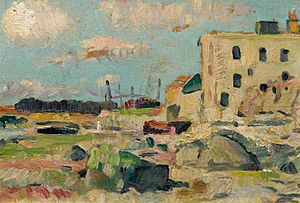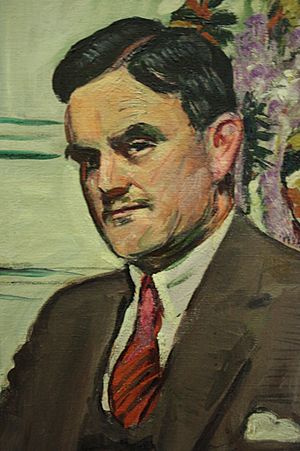Leslie Hunter facts for kids
Quick facts for kids
George Leslie Hunter
|
|
|---|---|

The Beach, Largo, at Low Tide, date unknown, Aberdeen Art Gallery & Museums
|
|
| Born | 7 August 1877 |
| Died | 7 December 1931 Glasgow, Scotland
|
| Nationality | Scottish |
| Known for | Graphic artist; Artist in paper media & Oils |
| Movement | Post-Impressionism |
| Awards | Artist Member of Glasgow Art Club |
| Patron(s) | T.J. Honeyman, Alexander Reid, Matthew Justice |
George Leslie Hunter (born August 7, 1877 – died December 7, 1931) was a Scottish painter. He is known as one of the four artists in a group called the Scottish Colourists. His birth name was George Hunter, but he started using "Leslie" in San Francisco. This became his professional name.
Hunter was very good at drawing from a young age. He mostly taught himself, only getting a few basic painting lessons. He spent about fifteen years in the United States, mainly in California. After that, he returned to Scotland. He also painted and drew in Paris. Later, he traveled a lot in Europe, especially in the South of France, the Netherlands, and Italy.
Hunter painted many different things. These included still lifes (pictures of objects), landscapes (pictures of nature), and portraits (pictures of people). His paintings are famous for how he used light. They became popular with art critics and collectors during his lifetime. Since his death, his paintings have become very valuable and are among the most loved in Scotland.
Contents
About George Leslie Hunter
Early Life and Moving to America
George Leslie Hunter was born in Rothesay, on the Isle of Bute, Scotland. This was on August 7, 1877. He was the youngest of five children. From a very young age, George loved to draw. When he was about thirteen, his mother arranged for him to have painting lessons.
In 1892, his family decided to move to California, USA. George was fifteen when they left Scotland. They first lived on an orange farm near Los Angeles. George enjoyed sketching and the warm weather. But he wasn't very interested in farming.
Starting as an Artist in San Francisco
In 1896, Hunter began working as an illustrator for newspapers and magazines. He met famous writers like Jack London in San Francisco. He drew pictures for magazines like Overland Monthly. In 1899, he first signed his work as "G. Leslie Hunter."
By 1902, Hunter joined a group of artists who wanted to be more independent. They formed the California Society of Arts. This group was different from the older art organizations. Hunter became a successful graphic artist in America. He created over two hundred illustrations for publications and books.
Discovering Fine Art
In 1904, Hunter visited Paris, France. He used the money he earned as an illustrator for this trip. Paris inspired him greatly. He decided then to become an oil painter. When he returned to San Francisco in 1905, he planned his first art show.
However, a big fire after the 1906 San Francisco earthquake destroyed his early paintings. After this, he moved back to Scotland and settled in Glasgow. He continued to work as an illustrator there. His first oil paintings were still lifes with dark backgrounds, like old Dutch paintings.
In 1908, Hunter was back in Paris. He saw an art collection that included bright, bold paintings by Henri Matisse and early works by Pablo Picasso. These paintings surprised Hunter. They made him think about art in a completely new way.
Developing His Style
Hunter started to become more successful after a trip to northern France in 1914. He visited the Etaples art colony. There, he was inspired by French art and the local scenery. He began to develop the unique style that would make him famous as a Colourist.
But World War I started, so he had to go back to Scotland. His work was noticed by Alexander Reid, an art dealer. In 1915, Hunter had his first solo art show in Glasgow. At this time, he mostly painted still lifes.
During the 1920s, Hunter became known with three other artists: John Duncan Fergusson, F. C. B. Cadell, and Samuel Peploe. These four artists became known as the Scottish Colourists. This name was first used in 1948, after most of them had passed away.
Travels in Europe
In 1922, Hunter began traveling a lot in Europe. He visited Paris, Venice, Florence, and the Riviera. His friend Fergusson sometimes joined him. These trips led to many new paintings. Hunter's style changed during this time. He started using small dabs of color to show shapes and forms.
When he returned from his first trips, in 1922, he lived in Fife, on the east coast of Scotland. From 1924 to 1927, he split his time between Fife and Glasgow. His paintings from this period include beautiful views of Loch Lomond. These landscapes were influenced by the artist Paul Cézanne. They became very colorful and full of atmosphere.
In 1925, Hunter's work was shown in London with paintings by Peploe, Cadell, and Fergusson. An art critic wrote that Hunter used colors in an inspiring way.
Hunter traveled to the South of France several times between 1927 and 1929. He stayed in Saint-Paul-de-Vence. He sent paintings back to his dealer in Glasgow and London. He spent a lot of time sketching, so he didn't finish many oil paintings. His trips to France ended with a successful art show in New York in 1929.
Hunter's Popularity
Hunter's paintings were well-liked by art critics during his life. He had successful art shows in Glasgow, London, and New York. Before he died, a newspaper called Glasgow Herald said that he was already famous for his landscapes and still lifes. They also said his new portraits would create a lot of interest.
Many years after his death, art shows of Hunter's paintings were still held. In 1953, a show of his watercolors and paintings in Glasgow attracted many visitors. An art critic praised one painting, saying it was done with such freedom that it couldn't be better.
In the early 2000s, Hunter's paintings began to sell for very high prices. In June 2010, one painting sold for £144,000 (about $180,000 USD). Another painting sold for £78,000 (about $98,000 USD). An art expert said, "This is a very special painting, so typical of Hunter."
Hunter's Artistic Style
For most of his life, Hunter focused on painting landscapes and still lifes. He used both pen and ink, and oil paints on canvas. His still lifes of fruit are very unique. He also painted many landscapes, especially of Scotland and France.
In his earlier paintings, Hunter was influenced by Paul Cézanne. Later, like the other Scottish Colourists, he was greatly influenced by French artists like Claude Monet and Henri Matisse. His paintings then started to use bolder and more energetic colors.
Hunter especially tried to capture the effects of light in his paintings. He would often paint the same objects or places under different lighting conditions. His brushstrokes were influenced by the French avant-garde (new and experimental artists). Art critics describe his later work as "open and free" and "energetic."
See also
 In Spanish: Leslie Hunter para niños
In Spanish: Leslie Hunter para niños


